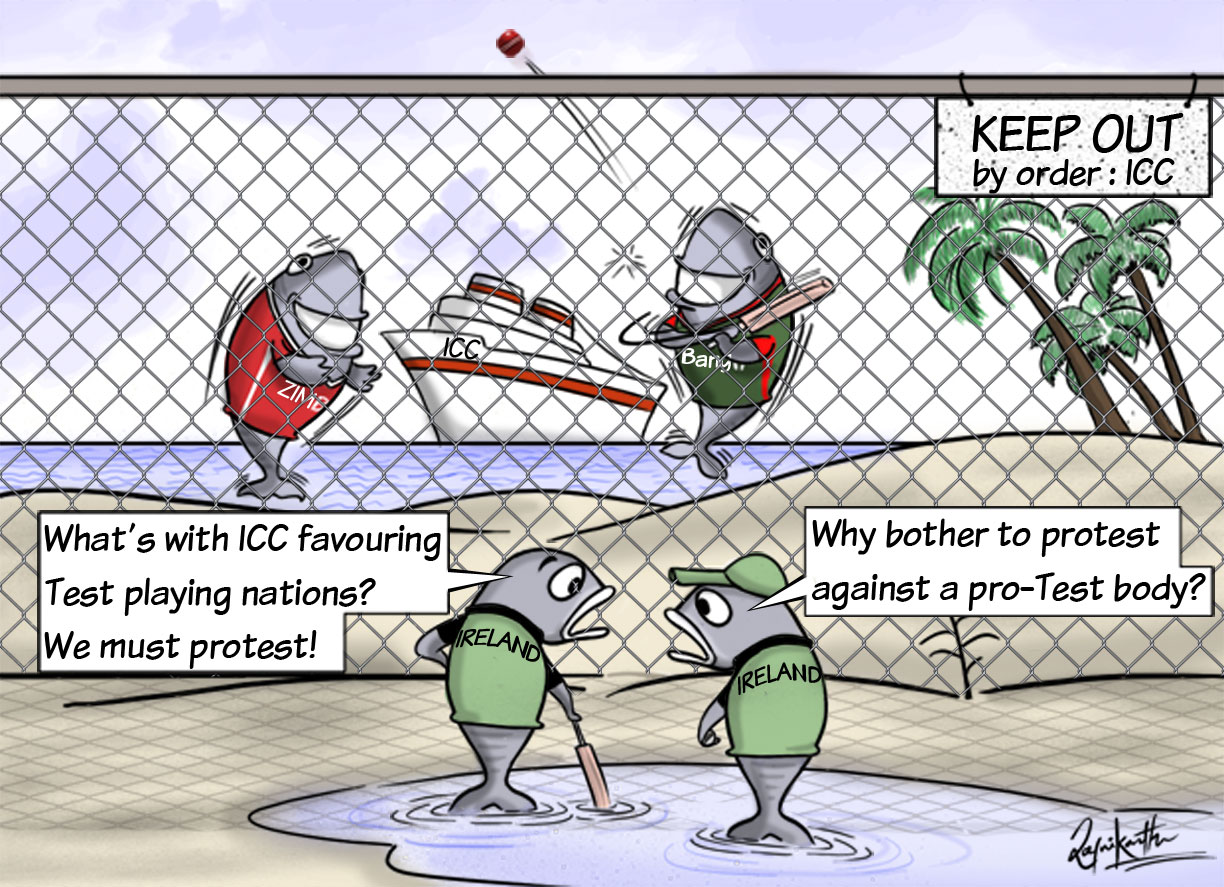 The news from the ICC chief executive’s committee meeting in Dubai that proposals to create a two-tier structure in Test cricket have been abandoned has dealt another body blow to those hoping to see change in the global game. Despite reported support for the plan from at least six Full Member nations, as well as from a number of high profile players, the weighty opposition of the BCCI ensured that discussion never got beyond the most tentative of stages–even if, according to one report, it got that far.
The news from the ICC chief executive’s committee meeting in Dubai that proposals to create a two-tier structure in Test cricket have been abandoned has dealt another body blow to those hoping to see change in the global game. Despite reported support for the plan from at least six Full Member nations, as well as from a number of high profile players, the weighty opposition of the BCCI ensured that discussion never got beyond the most tentative of stages–even if, according to one report, it got that far.
So how should cricket fans – and as you are taking the time to read these thoughts I will make the assumption that that includes you –be feeling today? Well, whatever makes up the cocktail of emotions you may be experiencing at the news I am pretty sure it won’t include surprise.
What is so frustrating is that this was patently a good idea. Test cricket has been under increasing pressure for a while. The appeal - not to mention financial clout - of Twenty20, particularly through the domestic franchise leagues, has meant that beyond its traditional English and Australian strongholds, Test cricket has struggled to find a foothold within a new, expanding audience. Beyond the small number of marquee Test series – the Ashes, Gavaskar-Border and the like – the traditional bilateral series has become more and more of an anachronism for increasing numbers of nations. Four-match series, let alone five or six, are now the exception rather than the rule as Tests are increasingly sacrificed to make space for more profitable international one-day and T20 fixtures.
But here, at last, was the opportunity, the prospect of a reboot, the chance to make Test cricket relevant with every match given “meaning and context” as Dave Richardson, CEO of the ICC, originally put it. And as we pause to consider the well-aired counter-argument, the fate of those ‘have-nots’ who might find themselves languishing in the second division, reflect for a moment. Ask any soccer fan if he would rather his team go through a season-long battle against relegation or a push for promotion –from and to whichever division - and you know which answer will come. And how many soccer teams have built their subsequent success on the back of the momentum generated by promotion to the English Premiership, for example?
Why should divisional cricket be any different?
“
Rather than stifle the growth of the ‘smaller’ nations who so fear life in Division Two, regular, competitive fixtures against similarly ranked teams would surely be an improvement on the present situation as under-resourced sides - when they play Test cricket at all - find themselves at the sharp end of hammerings from teams at the top of the rankings.
”
But we need those fixtures against the big teams, comes the cry. Lucrative for the board? Perhaps. But demoralising for the players? For sure. Which do you feel is most important? And wouldn’t an end-of-cycle promotion clash generate as much, if not more, interest than a meaningless bilateral match, regardless of the protagonists?
Yet for me it is the loss of yet another prospective avenue to the top table for the Associate nations which is hardest to take. Here was an opportunity for the top-performing Associate sides to take advantage of guaranteed fixtures against Full Member opposition - the one thing Associate cricket cries out for above all else – as well as provide an incentive for those teams just below the twelve who would make up the two divisions.
But once again the skewed priorities of a governing body happy to protect the perceived interests of the few over the many have been laid bare. With the Associates still reeling from the implications of their effective exclusion from the 2019 World Cup thanks to the reduction in eligible teams, cricket has again sent a signal that it is not interested in expanding beyond its narrow, established – and for ‘established’ read ‘full’ - membership.
As the 2016 ICC Annual Conference was concluding in Edinburgh, I spoke to Mohammad Shahzad, in town for Afghanistan’s ODI double-header with Scotland. Shahzad has been at the forefront of Afghanistan’s remarkable year, with their ODI series win over Zimbabwe followed up by a World T20 campaign which included that famous victory over West Indies, the eventual winners of the tournament. He is clear, however, as to what the long-term ambitions of his side are.
“The whole team’s goal is to play Test cricket. Inshallah we will,” Shahzad told me. “It’s not just me, not just the team, the entire country is waiting for the moment Afghanistan can play Test cricket."
“Everybody at home is excited and praying for us and we will try hard to achieve it.”
Can anyone deny that Afghanistan deserve their chance? For Associate cricket to develop it does not need charity, it needs opportunity. And the two division Test proposals would have provided it. We can only hope that the proposals for a thirteen-team ODI league do not suffer a similar fate. Because sadly, and too often, it appears that when it comes to a truly global game, prayers may well be all we have left.
Fast. Lite. Innovative. Shareable. Download our HW Cricket app!